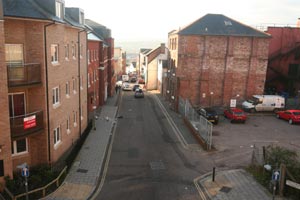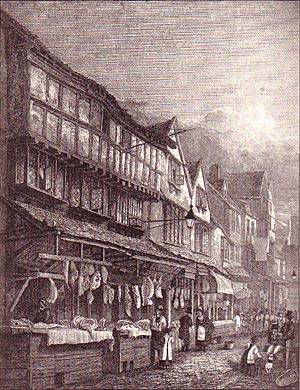
Smythen Street and Butchers Row
Page updated 23rd March 2015
 As the name
implies, Smythen Street was home to the blacksmith industry of Exeter.
It is situated in the old west quarter of Exeter, which
was a notoriously poor area in the 19th and early 20th century. The
main way into Exeter during the 11th and 12th century from the west,
was through West Gate, up Stepcote Hill and Smythen Street. The
original line of the route which is Roman, continued across South
Street
and cut across the modern Cathedral Yard to the east of St Petroc's,
across Broadgate to enter the High Street approximately opposite the
Guildhall. The map is circa 1905.
As the name
implies, Smythen Street was home to the blacksmith industry of Exeter.
It is situated in the old west quarter of Exeter, which
was a notoriously poor area in the 19th and early 20th century. The
main way into Exeter during the 11th and 12th century from the west,
was through West Gate, up Stepcote Hill and Smythen Street. The
original line of the route which is Roman, continued across South
Street
and cut across the modern Cathedral Yard to the east of St Petroc's,
across Broadgate to enter the High Street approximately opposite the
Guildhall. The map is circa 1905.
The street was home to Thomas Benet who was found guilty of heresy
for pinning notices on the Cathedral door stating 'We ought to worship
God only and no saints'. He was burnt at the stake, at Livery Dole, on
15th January 1532.
Butchers' Row
The top part of Smythen Street housed Butchers Row, where one side of the street was lined with nineteen butchers' shops, built by the City Chamber in 1499 and 1500. During the Cholera outbreak of 1832, Butchers' Row and all around were fumigated in a futile attempt to prevent the spread of the disease. Butchers' Row was effectively removed when the Lower Market was opened on 9 December 1836. The new building was twice the depth of the old Corn Exchange, and lay across the top of Smythen Street. The market offered a purpose built space for the butchers of Exeter.
James Cossins is always a reliable source for memories of many places in the city, and he described the difficulty of access to Butchers Row during the first decades of the nineteenth-century:
"The upper entrance to the Butchers' row was through Milk street, a pathway, the end a butcher's shop kept by Mr. England, and so narrow, that I have seen them take joints of meat from the stall to admit the horses' heads for the purpose of turning the corner. The cart entrance to the Butchers' row was under St. John's Bow, the arch being so low that carts were obliged frequently to partially unload."
As mentioned, Butchers Row was situated at the top of Smythen Street, approximately where the Corn Exchange (George's Hall) can be found. The Exeter Pocket Journal in 1796 throws up this little interesting extract:
Yelland,
Jos, cheesemonger, butchers-row
Youldon, Jas. butcher, butchers-row
Youldon, Edmund. butcher, butchers-row
Youldon, Benj. butcher, butchers-row
Youldon, Sam. butcher, butchers-row
Youldon, Jas. butcher, southgate-street
Youldon, Thos. butcher, george's-lane - is the top of Smythen St
Youldon, Grace. butcher, george's-lane
Youldon, S. grocer, high-street
Although there were other butchers in Butcher Row at this time, the list indicates how the trade was kept in the family.
Alexander Jenkins wrote in 1806 of Butchers Row:
"...consists of a narrow street, the buildings, in general, low and mean, with heavy hanging window shutters. Here the knights of the steel reside in a kind of community among themselves, slaughter their cattle and expose their meat for sale....the slaughtering of cattle, with the accumulation of dung, blood and thrown in heaps behind the houses, makes the Butchers Row a noisome place in the summer".
The Flying
Post described the slaughter of an ox in 1802 by our already mentioned,
Mr England:
"Yesterday the
largest ox that has been seen in this city for some time, fed on the
grounds of the Right Hon. Lord Courtenay, was slaughtered by Mr. George
England, butcher, in the butcherow. - Its weight is about 16 hundred,
and it measures full 8 inches thick on the breast. - This large and
fine animal was felled in an instant, by the new method of laying,
cattle:– how much preferable must this be, to the old practice of
beating down a poor animal with a sledge-hammer."
The following street directory indicates that by 1897, all the butchers shops in Smythen Street had gone.
Smythen
street, Market street to King street. 1 Partridge Charles, shopkpr
2 Denham D. & Co. wholesale haberdashers
4 Horwill. Wm. Hy. forage dlr
5 Raddan George, shopkeepr
7 Ingledon Wm. Jas. boot ma(ker)
10 Evans, Gadd & Co. druggists
12 Hitt Thomas, bird dealer
Wilcocks & Wilcocks (warehouse)
Mortimore John, wood dlr
13 YouldonSamuel, shopkeepr
14 Lee Albert Edwd. wood dlr
15 Vaughan Thomas, marine store dealer
18 Lee William, baker
19 Perry Mrs. Frances, shpkpr
20 Roleston Mrs. Ann, brush maker here is King st
22 Baston John, furniture bro
23 Stephens Mrs. Harriet, shopkeeper
24 Collins Edwd. Wm.shopkpr
25 Steer Mrs. Mary, shopkeepr
28 Daw Thomas, general dealr
.....here is John st.....
Wilcocks & Wilcocks (warehouse) (tea)
Evans, Gadd & Co.'s Warehouses
Denham D. & Co. haberdashers
On the corner of John Street and Smythen Street could be found:
Coachmakers' Arms P.H. Mrs. Annie Westlake
In June 1940, Smythen Street was chosen to have two brick built air raid shelters for the local inhabitants. Most of the street escaped damage during the blitz, despite the Lower Market at the top being burnt out. Little of the original Butchers Row and Smythen Street remains, with a carpark occupying a large site part way down, and a large block of social housing built in the 1990s occupying the site of the old Evans Gadd building. Paul Madeley, the former Leeds United footballer, on retirement, worked in his family's DIY business in Leeds. They opened a branch in the Evans Gadd building in the 1970s. The group was sold for £27 million in 1987, and the Exeter outlet closed.
Source: Kelly's Directory 1897, Exeter Flying Post, Reminiscences of Exeter by James Cossins, and the Express and Echo.
 Smythen Street from the Corn Exchange (George's Hall.)
Smythen Street from the Corn Exchange (George's Hall.)
 Looking up Smythen Street.
Looking up Smythen Street.
 Butchers Row by John Gendall.
Butchers Row by John Gendall.
│ Top of Page │